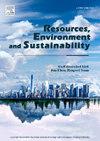全球钛产业链时空动态与结构弹性评价:来自贸易网络分析的启示
IF 12.4
Q1 ENVIRONMENTAL SCIENCES
引用次数: 0
摘要
钛是化工、冶金、机械制造、航空航天等领域的重要原料。评估全球钛贸易格局的时空动态,对于全面了解钛贸易形势,增强钛供应链的稳定性至关重要。为此,本文构建了钛矿、钛白粉、海绵钛和钛制品的全球贸易网络,并运用多种网络分析方法,深入研究了全球钛贸易格局的时空演变、贸易网络的拓扑结构和弹性特征。研究表明,全球钛贸易呈波动增长趋势,贸易流集聚性明显,网络规模不断扩大、密度不断加大,结构不断优化。近20年来,钛矿、钛白粉和钛制品的贸易量分别增长了约2.93倍、1.80倍和1.90倍。全球钛贸易网络呈现明显的核心-外围结构特征。四类钛商品交易网络的集中化系数均超过0.9,核心与外围边界清晰,各层之间的连通性存在差异。全球钛贸易网络的弹性随时间的推移而增强,其中钛白粉和钛制品贸易网络的弹性明显高于钛矿和海绵钛。但是,中国、美国、德国等关键节点的故障对网络连通性的影响仍然较大,网络抵御故意攻击的整体能力仍然有限。最后,提出了促进钛贸易合作、增强钛贸易网络弹性、维护钛供应安全的政策建议。本文章由计算机程序翻译,如有差异,请以英文原文为准。

Evaluating the spatiotemporal dynamics and structural resilience of the global titanium industrial chain: Insights from trade network analysis
Titanium is a crucial raw material in the chemical industry, metallurgy, machinery manufacturing, aerospace, and other fields. Evaluating the spatiotemporal dynamics of global titanium trade patterns is essential for a comprehensive understanding of the titanium trade situation and for enhancing the stability of the titanium supply chain. To this end, this paper constructs global trade networks of titanium ore, titanium dioxide, titanium sponge, and titanium products and utilizes various network analysis methods to deeply investigate the spatiotemporal evolution of global titanium trade patterns, the topology of the trade network, and the resilience characteristics. The study reveals a growing global titanium trade with fluctuations, significantly clustered trade flows, and expanding, denser networks with optimized structures. Over the past 20 years, the trade volumes of titanium ore, titanium dioxide, and titanium products have increased to approximately 2.93, 1.80, and 1.90 times their previous levels, respectively. The global titanium trade networks present significant core–periphery structure characteristics. The centralization coefficients of the four types of titanium commodity trade networks all exceed 0.9, with clear boundaries between the core and peripheral layers, as well as differences in connectivity across the various layers of these networks. The resilience of the global titanium trade network has increased over time, with the resilience of the titanium dioxide and titanium products trade networks significantly higher than that of titanium ore and titanium sponge. However, the failure of key nodes such as China, the United States, and Germany still has a greater impact on network connectivity, and the overall ability of the network to resist intentional attacks is still limited. Finally, this paper puts forward policy recommendations to promote titanium trade cooperation, enhance the resilience of the titanium trade network, and maintain the security of the titanium supply.
求助全文
通过发布文献求助,成功后即可免费获取论文全文。
去求助
来源期刊

Resources Environment and Sustainability
Environmental Science-Environmental Science (miscellaneous)
CiteScore
15.10
自引率
0.00%
发文量
41
审稿时长
33 days
 求助内容:
求助内容: 应助结果提醒方式:
应助结果提醒方式:


